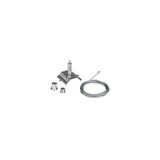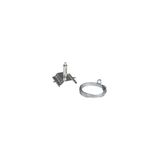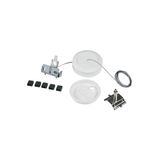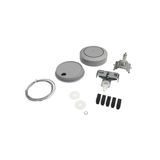Siteco Accessories/spare parts for light ribbon-/hose/-strip







siteco accessories for led strips Range and purpose
Projects go smoothly when every tiny part lands right the first time. This family covers the small but decisive pieces that make linear runs reliable: feed and joiner sets, taps for tees, sealed terminations, profile hardware, and ready-made jumpers. Platforms are 24 V and 48 V constant-voltage and CC module ecosystems; all parts are dimensioned to common board widths (8/10/12/14/20 mm) and bend radii that won’t stress solder pads. Materials are HF/LSF plastics, tinned copper, and anodised aluminium with clear torque and strip-length markings, so ceiling work is fast and repeatable on lifts.
siteco led strip connectors Interfaces and ratings
Push-in and solder-less blades clamp reliably on single- and double-sided FPCs; insulation displacement (IDC) styles speed shelf and cove runs where irons aren’t welcome. Rated typically 5–8 A per pole at 85–105 °C (series dependent), with polarity keys and printed +/–. Corner and “Z” joiners keep pitch through changes of direction; flex jumpers with 90° strain reliefs protect pads on doors and access hatches. IP20 parts serve interiors; gel-filled and gasketed kits reach IP65 for damp soffits. Wire acceptance is usually 0.34…1.5 mm²; transparent lids give inspectors visual confirmation of copper under the clamp.
siteco power supplies for led strips Electrical design and EMC
CV drivers land at 60/100/150/200/320 W nodes with PF ≥ 0.95, THD ≤ 10–15 %, and inrush data published for breaker diversity. Ripple is controlled for low-flicker dimming; 1–10 V and DALI-2 variants handle broadcast or channel control. Enclosures are slim IP20 for ceiling voids or IP65/67 for canopies; temperature classes and Tc points are printed on the label. Safety aligns with IEC/EN 61347-1/-2-13, emissions with EN 55015, and immunity with EN 61547; harmonics meet EN 61000-3-2. For long 24 V runs, feed both ends or step to 48 V to keep voltage drop and color drift off the punch-list.
siteco led strip mounting kits Mechanics, thermal, and finish
Clip sets, slide-in carriers, and suspension brackets match common trunking and C-rails, with SWL data so nothing is left to guesswork. Thermal tape is specified by W/m·K, not just thickness—choose the pad that keeps board Tc at least 10–15 K below its limit. Anti-vibration pads and captive screws prevent buzz in HVAC plenums. For food or coastal sites, stainless fasteners and silicone gaskets keep seals honest through washdown and salt fog. Opal and micro-prismatic covers manage glare; clear options maximise punch for retail.
Technical specifications and standards
- Connectors to EN 61984; glow-wire 750–850 °C where stated.
- Profiles and assembled lines align with EN 60598; LED modules to EN 62031 with LM-80/TM-21 life projections (typical L80 50–100 kh at rated Tc).
- IP per EN 60529 (IP20/44/65/67 by kit), impact up to IK08 for exposed runs.
- Conductor windows: 0.34…1.5 mm² on small joiners, up to 2.5 mm² on power feeds; strip length and torque printed on parts.
Applications and wiring practice
Retail shelves: quick-fit joiners speed planogram changes; keep feed spacing to hold uniform CCT along long price rails. Museums: low-ripple drivers and high-CRI boards with lockable dim levels protect exhibits. Hospitality coves: use sealed tails where soffits breathe to outside. Production benches: dim-to-task with DALI-2; publish minimum stable level so cleaners aren’t left in semi-dark. When schedules mention siteco end caps and profiles, include cap type, cover, finish, and gland thread on the same tag—procurement errors drop fast when those four lines are explicit.
Integration with controls and other hardware
DALI-2 DT6/DT8 drivers align with room controllers; 1–10 V is fine for simple zones. Keep SELV segregated in plastic conduit and bond metallic profiles where EMC demands it. Use matched glands on profile feed-throughs so enclosure IP isn’t lost at the last step. For brownfield shelves, pre-terminated jumpers reduce iron time and keep smoke detectors happy.
Selection criteria for B2B buyers
- Electrical: 24 V vs 48 V, feed distance, loop topology, and total current per run—dimension copper and protection accordingly.
- Optics: clear vs opal vs micro-prismatic by task, glare limit, and camera use.
- Thermal: choose profile mass and pad conductivity to hold Tc below the life-claim point.
- Environment: IP/IK, chemical exposure, and cleanability; specify stainless and silicone where needed.
- Connectors: pitch, board thickness, and ampacity; insist on visual-check lids for QA.
- Documentation: IES/LDT, Tc locations, torque tables, and wiring diagrams—auditors stop asking when the pack is complete.
Logistics and service notes
Keep two profile heights and one connector family across a floor—spares become interchangeable. Order spare diffusers and gaskets with the first drop; most late re-visits are water or dust ingress, not LED failures. If the BOM uses the legacy term siteco spare parts for light ribbon hose, map it to the current connector/end-cap sets in the quote to avoid mismatches on site.
Bankoflamps advantages for linear projects
We align optics, drivers, connectors, profiles, glands, and cut plans to your room data sheets and single-lines, then expose live EU stock before access nights are booked. Quotes typically land in about an hour with EAN/MPN, Tc limits, PF/THD, inrush, IP/IK, and cut-list codes, so nothing drifts mid-phase. Your portal shows lead times, shipment status, and downloadable price lists with validity dates; approved clients can use post-payment up to 30 days. We consolidate by line/zone to cut freight and on-site sorting, and your account manager cross-checks feed spacing, loop currents, DALI budgets, gland policy, and mounting hardware against the drawings—so cartons arrive lift-ready and crews finish once.